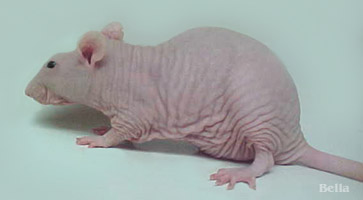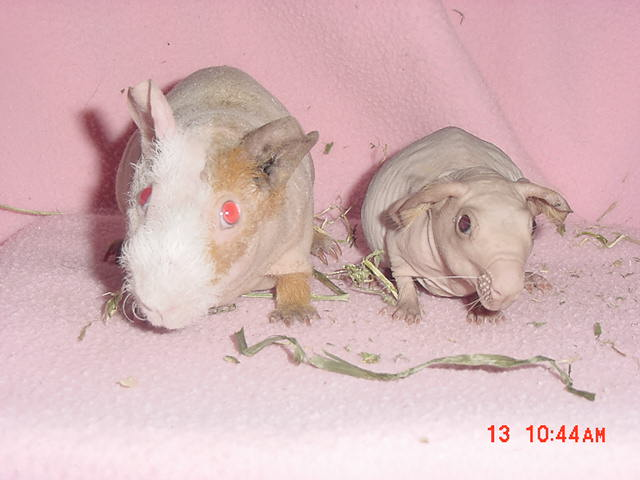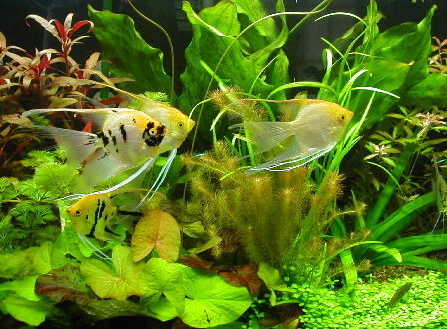
Rats and Mice
RATS
There are two basic types of hairless rats, true hairless and 'patchwork' hairless.
True hairless rats have no fur at all on their bodies and usually no whiskers either. Sometimes they have fur as pups which falls out by the time they are 2-3 months old. There are many different genetic strains of true hairless, most if not all of which have come from laboratories, where they are used extensively for medical research. They are missing a part of their immune system called the thymus, which makes them susceptible to disease and allergies. Depending on which strain they are they can be prone to tumors, eye and respiratory infections, heart or kidney disease, diabetes or skin problems. The average lifespan of true hairless rats is 9-18 months old.
As it is impossible to tell what strain a true hairless rat is without genetic testing, it is important to obtain true hairless rats from reputable breeders who can provide a pedigree. Breeders are working on stronger stains of true hairless rats through out-crossing with healthy furred rats. Hairless females with few exceptions do not make good breeders. They generally do not lactate at all or enough to support a litter, and cannibalism or abandonment is common. To produce true hairless pups, breeders will mate a hairless male (homozygous) to a furred hairless carrier female (heterozygous for hairless). Half of the offspring produced should be hairless, the other half will be furred hairless carriers.
Patchwork hairless rats maintain a certain amount of short, soft fur on their bodies and patches where they are bald. The fur will periodically fall out and grow back in throughout the rat's life in different patterns. They usually maintain whiskers though they are generally brittle and curly. While they are more prone to allergies, they are hardier than the true hairless rats and should live an average lifespan. The females also have no problems reproducing or raising litters. There are three strains of patchwork hairless rats:
1) Double rex: produced from two rex-coated parents (ReRe). Different from the other two strains as they tend to keep some fur on the face, head, feet and ankles while maintaining a mostly hairless body. If bred to a normal-coated rat they will produce rex-coated pups. If bred to a rex or velveteen-coated rat they will produce double rex pups.
2) Double Velveteen: produced from two velveteen-coated parents (CuCu). If bred with a normal-coated rat will produce velveteen-coated pups. If bred to a velveteen or rex-coated rat they will produce double velveteen pups.
3) Double velveteen/Double rex: produced from one double rex-coated parent and one double velveteen-coated parent (CuCuReRe). If bred to a normal-coated rat they will produce rex-coated and/or velveteen-coated pups.
Caring for a true or patchwork hairless rat is very similar to a furred rat. With less fur they need to maintain a higher body temperature which quickens their metabolism. They will eat and drink more than furred rats, and should be given some extra protein in their diets. A multi-vitamin formulated for rats can also be put into ther drinking water once a week. To help them stay warm a heating pad on LOW can be place under one third of their cage floor (make sure wires are out of range). Rats are social and should have a companion, but with true hairless rats I suggest keeping hairless with hairless as they will be more gentle with each other. Hairless rats can get scratched easily, and these should be tended to quickly with a safe topical cream. To further prevent scratches, use toys with no sharp edges, make sure hideaways have ample entry and exit space and that cages are coated wire, not just metal. Use a soft bedding instead of woodchips or corn cob which can irritate and itch. There are many on the market made from recycled newspaper, etc. Try to keep hairless rats away from other pets and put an air filter in the room to cut down on the chances of them developing allergies. It is very important to make sure the cage is clean and dry. Never keep your hairless rats by a window or in direct sunlight as they sun-burn easily.
MICE
There are two main types of hairless mice, nude mice and fuzzy mice.
Nude mice are more commonly found than the fuzzy variety. They have no fur at all and usually have no whiskers. The claws need to be clipped more often as they grow very quickly in some strains. They originate from laboratories where they have been used extensively in medical research since the late 1920's. Like hairless rats, they are also missing the part of their immune system called the thymus, making them very susceptible to disease and allergies. There are many different strains of nude mice, some of which are prone to a variety of ailments including neurological problems and diseases of the major organs. Even under laboratory conditions, nude mice usually do not live an average lifespan.
Most of the nude mice in the pet trade are laboratory surplus animals distributed to brokers and pet stores. Unfortunately with their compromised immune systems, these mice tend to pick up illnesses and not survive very long. Try to purchase nude mice from a reputable breeder which can give you a pedigree. Some breeders have succeeded in producing stronger nude bloodlines more suitable as pets. Nude female mice tend to not be good breeders, as they produce small litters and have a very short span of fertility (between 2.5 months to 7 months old). They sometimes do not lactate at all or enough to raise their litters, and abandonment or cannibalism is common. Nude mice should be bred by breeding a nude male (homozygous) to a furred nude carrier female (heterozygous for nude). Half of the pups produced will be nude and the other half will be furred nude carriers.
Fuzzy mice are more difficult to find as only a handful of breeders have them. There are a few strains of fuzzy mice but they generally have a fine covering of short soft fur which may fall out and grow back in periodically in different patterns. They may or may not have whiskers. Some are mostly bald with patches of fur on the head, shoulders and/or feet. The fuzzy mouse strains seem to be hardier than the nudes, although still more prone to allergies than regular mice.
Whether nude or fuzzy, hairless mice have higher metabolisms to help keep themselves warm. Extra protein should be added into their diets, and a multi-vitamin formulated for mice can be put into their water once a week. To help prevent scratches, it is best to keep hairless mice in an aquarium with a mesh screen lid. Toys should not have pointed aspects and hideaways should have ample exit and entry space. Avoid using woodchips as bedding, instead use a soft alternative bedding. It is very important to keep the cage clean, warm and dry. A heating pad on LOW under one third of the tank will help with warmth. An air filter in the room your mice are kept in will also help prevent allergies. Do not keep hairless mice near a window or in direct sunlight, as they are very vulnerable to sunburn.
Guinea Pigs
There are two types of hairless guinea pigs, Baldwins (above right) and skinny pigs (above left).
Baldwins are a rarer breed of guinea pig and not yet widely available in the pet trade. They are born with fur which falls out completely by 6-9 weeks of age. Usually they have no whiskers. Baldwins tend to be smaller than the average guinea pig, and are also more fragile. They seem to have lowered immune systems, and breeders are working to establish hardier lines of Baldwins more suitable as pets.
Unlike some other completely hairless rodents, female Baldwins show no problems in bearing and raising litters. This puts less limits on a breeder when trying to breed Baldwin offspring. Breeding two Baldwin parents (homozygous) will produce all Baldwin young. Breeding a Baldwin to a standard-coated guinea pig will produce half standard-coated young and half standard-coated Baldwin carriers (heterozygous for Baldwin). Breeding a Baldwin to a standard-coated Baldwin carrier will produce half Baldwin young and half standard-coated Baldwin carriers.
Skinny pigs are much more common than Baldwins and can often be found at pet stores. They have coarse fur on their heads, feet and ankles, and the rest of the body is bald or covered in very short fine fur. The whiskers are short and curled. Skinny pigs were first introduced in 1976 by the Charles River Laboratory in Canada, and initially they were not a very hardy breed. They are still being widely used for medical research. Breeders have worked extensively with skinny pigs through out-crossing with coated guinea pigs. Most of the lines available are strong and healthy and can expect a similar lifespan as regular guinea pigs. It is still advisable to purchase skinny pigs from reputable breeders over pet stores.
Female skinny pigs also seem to have no problems with bearing and raising litters. Breeding two skinny pigs (homozygous) together will produce all skinny pig young. Breeding a skinny pig to a standard-coated guinea pig will produce half standard-coated guinea pigs and half standard-coated skinny carriers (heterozygous for skinny pig). Breeding a skinny pig to a standard-coated skinny carrier will produce half skinny pig young and half standard-coated skinny carriers.
Whether Baldwin or skinny pig, hairless guinea pigs have a higher metabolism to help keep warm than their furred counterparts. They will tend to eat and drink more, this is completely normal. Try to keep hay contained in a hay net so it will not itch and irritate their skin. A multi-vitamin formulated for guinea pigs can be added to their drinking water once a week. Do not use woodchips as bedding but instead a soft alternative bedding. Purchase a cage with a solid bottom and coated wire. A heating pad on LOW placed under one fourth of the cage will help keep them warm. Provide a nest box (not directly over heated area) with ample exit and entry space which they can retreat to. This will also help keep them warm. It is important to keep their cage clean and dry. Do not keep hairless guinea pigs near windows or in direct sunlight as they are very susceptible to sunburn.

Syrian Hamsters
Hairless Syrian hamsters are quite rare in the pet trade and are sometimes referred to as 'alien' hamsters. They have no fur at all on their bodies, and usually do not have whiskers. They have lowered immune systems which makes them more susceptible to disease, and they often will not live an average lifespan though it is possible. Female hairless hamsters do not make good breeders, as they do not lactate at all or enough to sustain their litter. Abandonment or cannibalism is common in these cases. Hairless hamsters should be produced by breeding a hairless male (homozygous) to a furred hairless carrier female (heterozygous for hairless). Half of the pups will be hairless and the other half will be furred hairless carriers.
Care for a hairless hamster is similar to a regular Syrian hamster. To help keep warm they have higher metabolisms and will require some extra protein in their diets. A multi-vitamin formulated for hamsters can be put in their drinking water once a week. An aquarium with a secured mesh lid is best to help prevent escapes and scratches. Toys should not have any pointed parts and hideaways should have ample exit and entry room. Do not use woodchips as bedding but a soft alternative bedding instead. A heating pad on LOW under one third of the tank will also help keep them warm. It is very important to keep the enclosure clean and dry. Do not keep hairless hamsters near a window or in direct sunlight as they are very susceptible to sunburn.






